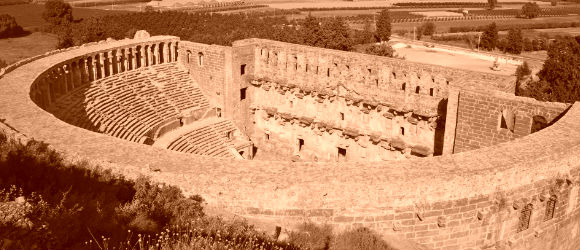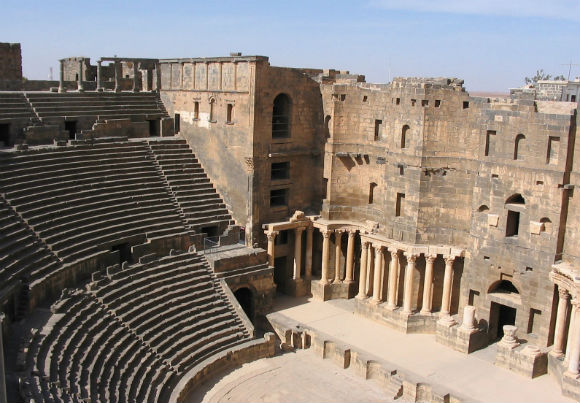Aspendos was an ancient Greco-Roman city in Antalya province of Turkey. It is located 7 kilometres (4.3 mi) northeast of central Serik.
Aspendos was an ancient city in Pamphylia, Asia Minor, located about 40 km east of the modern city of Antalya, Turkey. It was situated on the Eurymedon River about 16 km inland from the Mediterranean Sea; it shared a border with, and was hostile to, Side. According to later tradition, the (originally non-Greek) city was founded around 1000 BC by Greeks who may have come from Argos. The wide range of its coinage throughout the ancient world indicates that, in the 5th century BC, Aspendos had become the most important city in Pamphylia. At that time the Eurymedon River was navigable as far as Aspendos, and the city derived great wealth from a trade in salt, oil, and wool.
Aspendos did not play an important role in antiquity as a political force. Its political history during the colonization period corresponded to the currents of the Pamphylian region. Within this trend, after the colonial period, it remained for a time under Lycian hegemony. In 546 B.C. it came under Persian domination. The face that the city continued to mint coins in its own name, however, indicates that it had a great deal of freedom even under the Persians.
In 467 B.C. the statesman and military commander Cimon, and his fleet of 200 ships, destroyed the Persian navy based at the mouth of the river Eurymedon in a surprise attack. In order to crush to Persian land forces, he tricked the Persians by sending his best fighters to shore wearing the garments of the hostages he had seized earlier. When they saw these men, the Persians thought that they were compatriots freed by the enemy and arranged festivities in celebration. Taking advantage of this, Cimon landed and annihilated the Persians. Aspendos then became a member of the Attic-Delos Maritime league.
The Persians captured the city again in 411 B.C. and used it as a base. In 389 B.C. the commander of Athens, in an effort to regain some of the prestige that city had lost in the Peloponnesian Wars, anchored off the coast of Aspendos in an effort to secure its surrender. Hoping to avoid a new war, the people of Aspendos collected money among themselves and gave it to the commander, entreating him to retreat without causing any damage. Even though he took the money, he had his men trample all the crops in the fields. Enraged, the Aspendians stabbed and killed the Athenian commander in his tent.
When Alexander the Great marched into Aspendos in 333 B.C. after capturing Perge, the citizens sent envoys to him to request that he would not establish that he be given the taxes and horses that they had formerly paid as tribute to the Persian king. After reaching this agreement. Alexander went to Side, leaving a garrison there on the city’s surrender. Going back through Sillyon, he learned that the Aspendians had failed to ratify the agreement their envoys had proposed and were preparing to defend themselves. Alexander marched to the city immediately. When they saw Alexander returning with his troops, the Aspendians, who had retreated to their acropolis, again sent envoys to sue for peace. This time, however, they had to agree to very harsh terms; a Macedonian garrison would remain in the city and 100 gold talents as well as 4.000 horses would be given in tax annually.
In 190 BC the city surrendered to the Romans, who later pillaged it of its artistic treasures. Toward the end of the Roman period the city began a decline that continued throughout Byzantine times.
Aspendos,



Aspendos Ampitheater is an incredible site to see. The ruins are well preserved and it was a facsinating trip. Beware, it is 10tl to park, 15tl to get in and then you still have to pay 1Euro to use the toilet, 2E to take photos of camels and gladiators (which is only demanded afterwards!). We were also sold a camel…
My husband and I travelled to Turkey recently for a holiday we covered over 4 thousand Kms and had the most wonderful holiday. We found Turkey an amazing place very self sufficient culturally different to what we know and people very friendly. Lots of wonderful sights to see. I would love to go back again some time. One of the…
The theatre is gorgeous, but well worth the walk around to site to see the view of the aqueduct. Like Perge, this is one of the more expensive sites to get into at 15L each and another 5L for the parking.
Whatever you do, make sure you go off season, and if you are in high season, don't go on…
Well… you really got to see it. One woman (whether local or a tourist I don't know) just stood in the middle of the theater and started to sing. Suddenly ALL the tourists in the area shut up and listened to her, because the feeling of her voice in the ancient theater, perfectly audible in any corner was just amazing!
I heard this perfect acustic in Aspendos and in Collessium; I do not n-know any more on the world but you must see this ruins
The well protected amphitheatre is amazing and was built in 155 by the Greek architect Zenon. It seats 12000 people and is known as the best preserved theatre of antiquity.
Well worth the 10 Lira to get in. Awesome spectical of engineering, don't know how they did it back then. Acoustics are amazing, able to hold a conversation form opposite sides without shouting.
gets a bit chilly in the evening but show was fantastic
this really takes you back to roman times, the guide was well informed of the history and could answer any question that he was asked
Definitely take water with you! We went on our own and not as part of a trip, however, I would have liked to have had more of the history from a guide, but just walking around a working amphitheatre of that age and wondering how they managed to build something so impressive that has lasted so long is remarkable.